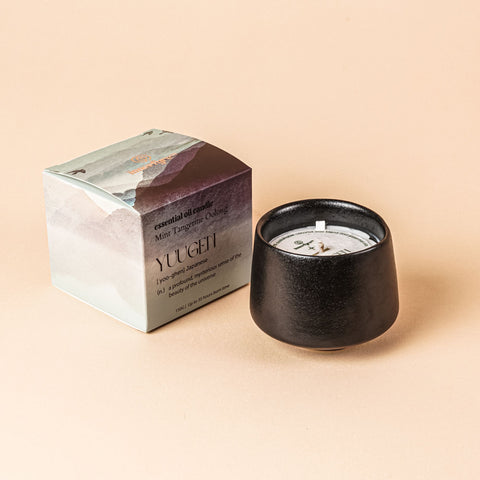
What You Need to Know About Candle Waxes
As the candle's defining feature, wax is critical for making a good candle.
To be able to ensure that you get the most out of your wax candle experience, it’s best to know everything about candle wax and why it matters.
Being a candle lover, you may have wondered, where does wax come from? And with a lot of choices — such as soy wax, beeswax, coconut wax, rice bran wax, which candle wax is best? In this handy guide, let’s discuss the various types of wax used to make scented candles.
What exactly is wax?
Wax, in general, is a flammable, carbon-containing solid that melts when heated above room temperature.
In other words, it is the fuel for the candle. When you light a scented candle, the wax melts, vaporizes, and burns, producing heat and light. Almost any oil can be converted into wax, providing a plethora of options for use in candles.
What is the composition of candle wax?

There are numerous types of wax that can be used to make scented candles. For thousands of years, beeswax has been used in the production of candles, whereas coconut wax candles, as well as petroleum wax candles, are relatively new innovations.
Each type of candle wax has its own unique properties, with some doing better at holding and transmitting fragrance while others excel at burning slowly and producing a smoke-free flame.
What is the best candle wax?
Each type of candle wax has advantages and disadvantages, making it difficult to choose a clear winner.
This is why there are so many different kinds of candle wax (and candle wax blends) available. Read on to get to know each type of wax, so you can then decide which one is best for you.
Which wax candle has the longest burn time?
Soy wax candles were generally thought to have the longest burn time, but each year new improved candle wax formations using new ingredients are created, allowing for even slower burning candles.
The length of time your candle burns is greatly influenced by factors such as where you burn the candle, the temperature of the room, the fragrance oils, the wick, and the container the candle is in, among many others. All these make it difficult to predict how long your candle will last.
Which candle wax produces the most scent throw?
Currently, paraffin waxes are thought to be the best for producing a strong fragrance, which is why many high-end brands continue to use paraffin wax in their candles.
While paraffin wax may have reigned supreme for the past decade or so, newer natural waxes such as soy, coconut, and rapeseed wax are fast improving, and it just may be a matter of time before these natural wax candles take over.
Is candle wax toxic?

Let's start by saying that you shouldn't eat your new scented candles because they don't taste as delicious as they smell!
While many candles are created with non-toxic food-grade paraffin wax, which is commonly used in cosmetics and food, we don't recommend taking the risk. When certain waxes are burned, some amounts of chemicals are released into the air.
In particular, when paraffin wax is burnt, it emits some volatile organic chemicals, such as toluene. While this may not be a cause for concern, (researchers found that the level of chemicals produced by each type of candle was much below that which would cause human health issues), there are lots of other candle wax options for individuals who want to avoid it.
That said, natural wax candles including soy, rapeseed, coconut, and beeswax are the greatest choice for consumers who prefer candles that burn cleanly and don't pollute the air inside their homes.
According to some claims, beeswax can even help clear the air.
If you start to feel unwell while burning candles or after inadvertently ingesting wax, seek medical treatment immediately; it's possible that you're allergic to one or more of the candle's contents.
Pets should be treated with caution because some of the components in scented candles are hazardous to them. They should be taken to the clinic if they show symptoms after having accidentally eaten or been exposed to your candle collection.
The Different Types of Wax
Let’s take a closer look at the most common types of candle wax used in scented candles.
Soy Wax

Many candle brands use soy wax because it is often considered more environmentally friendly than paraffin wax, burns slower and cleaner (with less soot), and is less expensive than some other waxes.
Soy wax candles generally have a more subtle scent throw due to the fact that soy wax does not retain as much fragrance – many people prefer this softer scent, but it all depends on your nose's sensitivity!
Soy candles are relatively new, having been invented in 1996. Soy wax is a soybean oil-derived vegetable wax. Harvested soybeans are cleaned, dehulled, cracked, and rolled into flakes to extract the oil.
After extracting the oil from these flakes, it is hydrogenated, a process that converts the unsaturated fatty acids in the oil to saturated fatty acids. This lowers the melting point of the oil, allowing it to solidify at room temperature and be ready for candlemaking.
While it is a more environmentally friendly option than paraffin wax, it does have a few drawbacks. Soybean oil is a byproduct of the enormous soybean industry, and there are concerns about deforestation and the use of pesticides and fertilisers in soybean production. Without proper safeguards, the World Wildlife Fund cautions that the soybean industry can cause widespread deforestation and displacement of small farmers and indigenous peoples throughout the globe.
What’s a soy wax blend?
Soy candle wax is frequently combined with other waxes to maximize the benefits of both.
Vegetable oils, such as coconut wax, palm wax, or beeswax, are frequently added. Numerous candle manufacturers also use paraffin and soy wax blends. Generally, a blend will be labelled as a soy wax blend if it contains at least 51% soy.
Soy Candle wax Benefits
- Because soy wax burns slowly, you'll get a longer-lasting candle for your money than you would with traditional paraffin wax candles.
- Soybeans are a natural and biodegradable resource.
Coconut Wax

Coconut wax is one of the newer candle waxes to hit the market, and we're seeing an increasing number of candle makers offering these. It's more expensive to use, but many people believe it's worth it because of the outstanding scent throw and even burn.
Coconut wax has a silky, creamy white colour, and is also environmentally friendly. Coconuts are a sustainable, high-yield crop, therefore harvesting the oil is an organic procedure. We've also listed the brands of sustainable scented candles in Singapore if you'd like to check this out!
Coconut Wax Candle Benefits
- Coconut wax candles are slow-burning and have a luxurious feel to them
- Coconut wax boasts of ab outstanding hot and cold scent throw.
- Coconut wax is a sustainable, environmentally-friendly candle wax option.
Paraffin Wax

Prior to the entry of soy wax and coconut wax in the market, there was paraffin. Paraffin wax (also known as mineral wax) is still popular with many high street candle brands because it retains colour and scent exceptionally well and is readily available as a by-product of the oil industry.
Environmentalists frequently demonise paraffin wax as a waste product of the crude oil refinement process. This does not necessarily make it one of the most toxic ingredients out there, and there is always the benefit of reusing parts of the oil that would otherwise be discarded.
At this time, more research is needed, as there is no conclusive evidence that burning paraffin candle wax is harmful to your health.
Paraffin Wax Candle Benefits
- Paraffin wax candles are a good option if you prefer your candle to have a strong scent.
Beeswax

Beeswax is the earliest type of candle wax known to man. It originated with the Egyptians, who dipped papyrus leaves in wax and then burned them. However, it is not frequently used in scented candles because the wax has a distinct honey aroma that does not mix well with other scents.
Beeswax candles are considered among the healthiest options because they emit no smoke or soot and can actually help purify the air. Beeswax is derived naturally from honey; bees produce it as part of their daily hive building activities.
Many scented candle makers who use beeswax will incorporate another type of candle wax into their creations.
For example, Boy Smells candles are made with a blend of coconut and beeswax. The beeswax is added to help firm up the natural soft texture of the coconut wax.
One of the discussions involving beeswax, however, is its sustainability. People for the Ethical Treatment of Animals also report that numerous bees are killed or have their wings and legs ripped off as a result of careless handling in the harvest of beeswax.
Beeswax Candle Benefits
- Beeswax is produced and processed naturally.
- Beeswax is beneficial to health and aids in the purification of the air.
Rapeseed Wax

Rapeseed wax (sometimes referred to as Canola wax) exhibits exceptional fragrance retention, throw, and burn time.
It's a relatively new wax for scented candles, and independent brands (particularly those based in Europe) are beginning to use it as a more sustainable alternative to soy wax.
Rapeseed is a brilliant yellow flowering plant from the mustard or cabbage family that is a more sustainable, renewable, and environmentally friendly alternative to mineral wax or waxes generated through intensive farming methods.
Rapeseed Wax Candle Benefits
- Rapeseed wax is produced locally, resulting in a lower carbon footprint.
- Rapeseed wax is highly fragrant and burns slowly.
Rice Bran Wax

Rice bran wax is made from rice bran oil, which is extracted or pressed after the grains have been separated from the husks of rice. The oil is then dewaxed, yielding dewaxed oil and crude wax, which can be processed further to yield rice bran oil and wax.
The production of rice bran wax offers value to the supply chain because it repurposes raw materials that would otherwise be discarded.
Rice bran wax is harder than paraffin wax, thus providing a more consistent, bright flame for longer periods of time, while also being gentle to the environment.
These eco-friendly wax candles don't produce any smoke or excess dripping, resulting in a clean burn and a soft, warm glow in your home.
Rice Bran Wax Candle Benefits
- Rice bran wax is sustainable and adds value to the production chain.
- Rice bran wax’s firmer texture allows it to burn more consistently over long periods of time.
Choose the Right Wax Candle
Now that you know the pros and cons of each wax candle time, it’s time to choose the best one for your home. Alternatively, you may also find yourself choosing among candles, diffusers, or incense.
At Innerfyre Co, all of our candles are made from a luxurious wax blend that contains coconut wax and rice bran wax. Vegan-friendly and non-toxic, this unique combination allows us to infuse each candle with 10-12% essential oils, compared to the typical 4-8% fragrance oil you will find in regular soy and paraffin candles.
Shop for Scented Candles in Singapore today.

